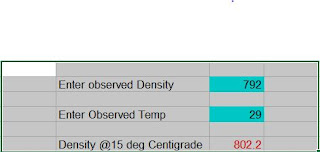- Myth Flash Point testing of sample contaminated with Gasoline is highly dangerous - Part 4 of X
Myth - It is highly dangerous to test flash point of samples contaminated with Gasoline
Fact - False. Fact, it is as safe or dangerous as testing any sample with naked flame.
Open and watch following YouTube videos clicking links for further details:
Initial historical Flash Point Test - open cup
See the naked flame Vs presence of fuel. Only vapors burn and not liquid.
 |
| Naked flame over kerosene sample |
 |
| Kerosene vapor only burn at right temperature and quantity |
 |
| Fire easily extinguished on cutting off air |
How Gasoline burns in a beaker - it is safe
See second half of the video of Gasoline, Alcohol fires
 |
| Only vapor burn |
 |
| See how safe it is. Controlled fire |
See the relative combustion property. Excellent video on Petroleum Product Knowledge of different fuels and their combustible nature.
 |
| Different common fuel samples |
 |
| Kerosene sample |
 |
| Av. Gasoline Sample |
 |
| Gasoline fire extinguished by putting bottle cover |
Learning :
a) only vapor burn
b) Liquid gives vapor only at certain minimum temperature
c) minimum vapor quantity require before liquid gives flash point and then burn
d) it is easy to extinguish fire - by cutting oxygen (air), by covering container with lid. In fact closed cup flash point cup ( Tag, Abel & PMCC) design takes care of auto lid closer.
e) closed cup flash point test like Abel, Tag, PMCC etc automatic control air supply thru cup cover
f) Good idea to keep Flash point test site clean of combustible materials like fuel samples, paper stationary, record files, books and source of fire/spark like match box etc
g) keep suitable portable fire extinguisher one very small and one of bigger capacity handy in near reach, clear of obstruction and keeping laboratory door in mind.
ASTM D93 has specified following warning at 11.1.2.
(Warning -quality not safety— Exercise care when using a gas test flame. If it should be extinguished it will not ignite the vapors in the test cup, and the gas for the test flame that then enters the vapor space can influence the result.)
(Warning—The operator should exercise and take appropriate safety precautions during the initial application of the ignition source, since test specimens containing low-flash material can give an abnormally strong flash when the ignition source is first applied.)
Indian 1448 [ P:20 ] Abel Flash Point specified following warning at 1.4.1
Regard should be given to the requirement in the method to use ignition devices and open flames in close proximity to the surfaces of heated flammable or combustible liquid samples. This generally requires a different safety approach to normal laboratory practice where flammable and combustible liquids are deliberately kept in closed equipment, and also well away from any potential or known ignition sources.
Safety Principles -
a) Always assume the sample may be congaing volatile contaminates like Petrol or Naphtha and take appropriate safety precautions. Apply first flame, without heating, in manual equipment by keeping flash point cup on working bench and not the equipment itself.
b) Work with all precautions and good practices, but always believe fire is mighty and will sure take place. Always be ready and have a safety plan ready and rehearsed well. This will help in controlling fire in first few seconds before it spreads and become unmanageable, causing a very costly consequence.
a) Always assume the sample may be congaing volatile contaminates like Petrol or Naphtha and take appropriate safety precautions. Apply first flame, without heating, in manual equipment by keeping flash point cup on working bench and not the equipment itself.
b) Work with all precautions and good practices, but always believe fire is mighty and will sure take place. Always be ready and have a safety plan ready and rehearsed well. This will help in controlling fire in first few seconds before it spreads and become unmanageable, causing a very costly consequence.
Author's Profile
Follow me on twitter @RJPatel13 to get notification when my new post is available in my blog.

Comments